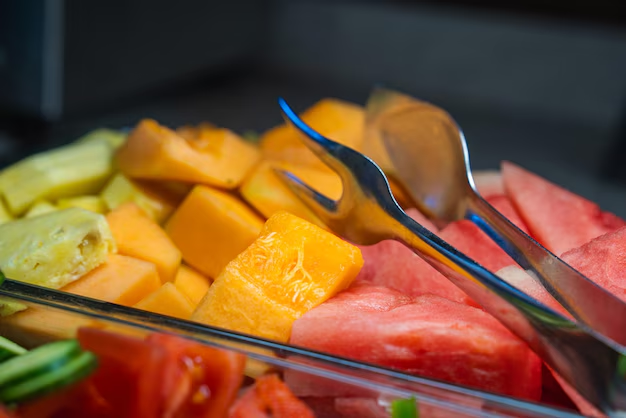Maximize Your Freshness: Fruit Storage Strategies for a Longer Fridge Life
Who doesn't love biting into a crisp apple or a handful of sweet grapes? Unfortunately, fruits often don’t stay fresh for long, leaving you with a fridge full of spoiled produce. The good news? With some simple strategies, you can extend their longevity and savor your favorite fruits for days, if not weeks, longer. Explore these effective techniques and discover how you can make your fruit last longer in the refrigerator.
🥶 The Cold Truth: Understanding Refrigeration
Why Refrigeration Works
Refrigeration is a prevalent method for preserving fruit due to its ability to slow down ripening and decay. The cool temperatures of a fridge hinder the growth of bacteria, thereby prolonging the freshness of fruits. However, understanding the optimal conditions for different types of fruits is key to maximizing storage time.
Temperature and Humidity: The Dynamic Duo
The ideal refrigerator temperature is usually between 33°F and 40°F. However, humidity levels play an equally important role. High humidity is preferable for leafy greens and certain fruits, helping to maintain moisture in the produce and preventing wilting. Conversely, low humidity is best for fruits that are more prone to mold growth in moist environments.
🍑 Tailoring Storage to Fruit Types
Berries: Small but Mighty
Berries, such as strawberries, blueberries, and raspberries, are particularly sensitive to moisture. Excess water can lead to rapid mold growth. Here's how to handle them:
- Pre-rinse caution: It's best to wash berries just before consumption. If washing beforehand, thoroughly dry them to prevent mold.
- Vinegar rinse: A solution of water and vinegar can help kill bacteria before storing.
- Container choice: Store in a breathable container lined with paper towels to absorb moisture.
Apples and Pears: Crisp by Design
These fruits release ethylene gas, which can speed up the ripening process of nearby produce.
- Separate storage: Keep apples and pears away from other fruits and vegetables.
- Refrigerator crispers: Use humidity-controlled crisper drawers set to low humidity.
- Check regularly: Periodically assess for ripening or bruising and remove spoiled fruits promptly to prevent spoilage spread.
Citrus Fruits: Juicy and Refreshing
Oranges, lemons, and limes are more forgiving due to their thick skins.
- Avoid airtight bags: These can create too humid an environment.
- Refrigerator placement: They do well stored in mesh bags or in the main refrigerator compartment.
- Beware of cuts: Once a citrus fruit is cut, it should be consumed within a few days.
Bananas: Slow the Spotting
Bananas are best ripened at room temperature but may require refrigeration once ripe.
- Ethylene awareness: Keep bananas away from ethylene-sensitive fruits to prevent early ripening.
- Skin changes: The peel may darken in the fridge, but the fruit inside remains good to eat.
- Wrap the stems: Covering stems with plastic wrap or foil can slow ethylene emission.
Stone Fruits: Handle with Care
Peaches, plums, and cherries are delicate and should be handled accordingly.
- Ripeness rule: Store stone fruits at room temperature until they ripen, then refrigerate to prolong freshness.
- Softness check: Gently squeeze to test for ripeness and consume as soon as they reach peak condition.
🧑🍳 Practical Tips for Savvy Storage
Use Proper Containers
- Ventilated containers: Allow for airflow, reducing moisture buildup.
- Mason jars or glass containers: These help maintain consistent moisture levels without excess humidity.
Avoid Overcrowding
- Space out: Overcrowding can inhibit air circulation and lead to uneven cooling.
- Layer wisely: Place heavier fruits on the bottom to prevent bruising of more fragile pieces.
Ethylene Management
Understanding which fruits emit and absorb ethylene can assist in strategic storage.
- Emitters: Apples, pears, bananas, mangos.
- Sensitive: Berries, leafy greens.
📝 Handy Summary: Key Tips for Fruit Longevity
- Berries: Wash just before eating, use paper towels for moisture.
- Apples and Pears: Store separately to harness their ethylene emit.
- Citrus: Best in mesh bags; consume cut pieces within days.
- Bananas: Keep away from other fruits, cover stems.
- Stone Fruits: Ripen outside, refrigerate when ready.
- Containers: Opt for breathable and glass options.
🚀 Proactive Solutions: Next Steps
Now that you're equipped with these insights, take a moment to assess your current fridge situation. Determine which fruits might need a new home on a different shelf or in a specialized container. Consider labeling drawers for high or low humidity and researching the specific needs of exotic fruits that may not fit the standard categories.
Incorporating these storage strategies into your routine requires little effort but offers substantial rewards, resulting in less food waste and enhanced enjoyment of nature’s bounties. By understanding the intricacies of fruit preservation, you're empowered to make the most of every grocery run, ensuring you always have delicious, fresh fruits just a reach away.
Revolutionize your fruit storage habits today, and savor the freshness that follows. Enjoy the extended life of your healthy snacks, knowing you're one step closer to mastering the art of food storage and maximizing your refrigerator's potential.
